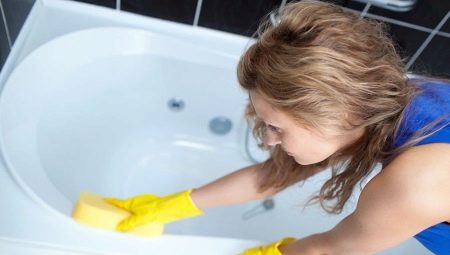The bathroom needs regular maintenance, as elevated air temperature and humidity contribute to the constant formation of various types of pollution. The ability to quickly and efficiently clean the bathroom will greatly facilitate the cleaning process. It is important to know some tricks that will help not only to cope with the existing pollution, but also to maintain cleanliness in the room for a long time. Effectively clean the bathroom to shine without any difficulties and high costs.
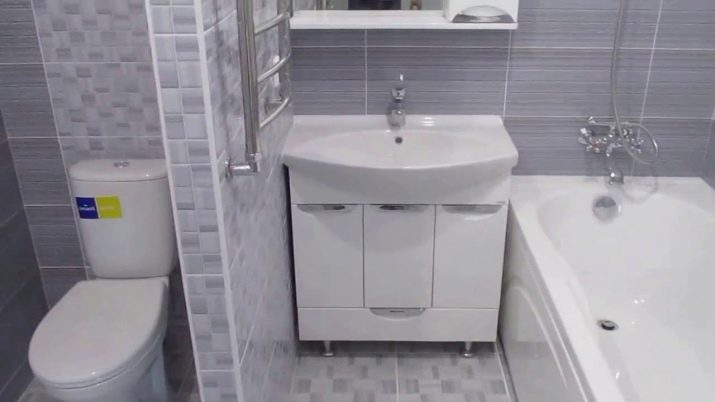
What pollution are there?
The bathroom needs to be kept clean. When cleaning, it is easiest to cope with ordinary dirt, the cause of which is most often caused by soapy deposits and dead skin. To remove such dirt, it is enough to wash it off with water immediately after the appearance. The ingested dirt is more difficult to remove, and can also harm not only various surfaces and plumbing, but also human health.
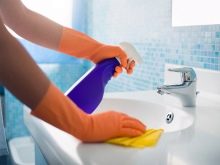

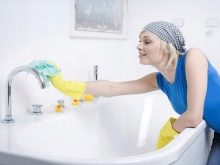
One of the most unpleasant and dangerous types of pollution is mold.
Most often, mold appears on the seams of tiles or on surfaces treated with sealant. The fungus significantly spoils the appearance of the room, and can also adversely affect the health of households. Vital products of mold that enter the human body by airborne droplets are toxic. Such pollution can provoke the following diseases:
- allergic reactions;
- asthma;
- candidiasis.
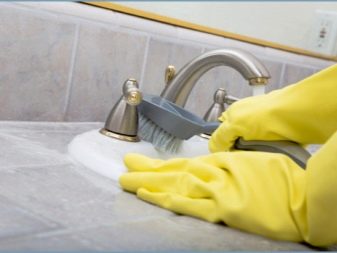
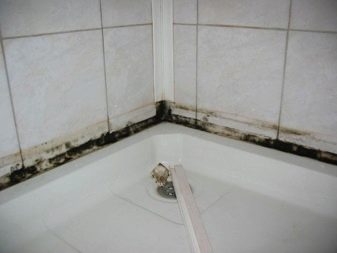
The cause of the appearance of the fungus in the bathroom can be various factors. Mostly mold is affected by:
- High humidity in the room. After washing or taking water procedures on various surfaces (ceiling, walls, tile joints, cast-iron pipes), condensation forms, which significantly affects the level of humidity. Often in the bathroom there are problems with plumbing. Leakage of taps also contributes to increased humidity.
- Poor ventilation or lack thereof. If the ventilation duct is clogged or has openings of insufficient diameter, air circulation is disturbed and humid air does not leave the room. A permanently closed bathroom door also prevents good ventilation.
- Lack of natural light. Only a few private house owners can boast a window in the bathroom. Most often, the bathroom is not accessible for the penetration of sunlight. Ultraviolet radiation prevents the emergence and spread of the fungus, as it is detrimental to it. The lack of sunlight creates favorable conditions for the formation of mold.

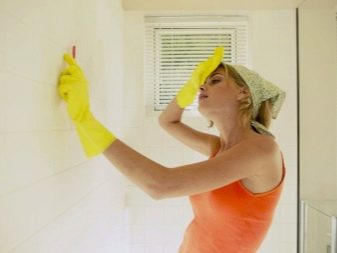
One of the most common types of bath contamination is yellowness. The cause of the yellow plaque on the plumbing are various chemical impurities that are contained in water. The water entering our house through worn-out communication systems is filled with particles of rust and various salts. These substances also provoke the formation of yellow plaque on the surface of plumbing.
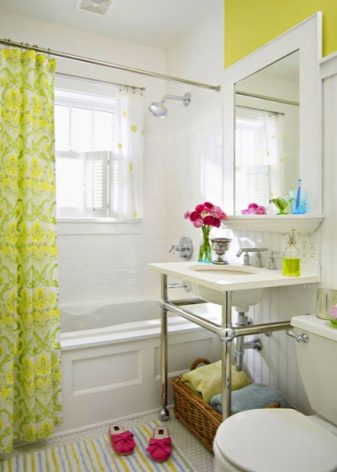
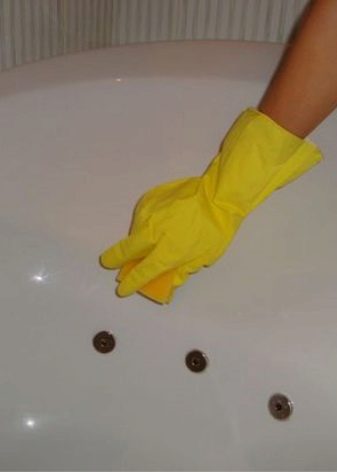
Yellow stains appear mainly near the drain hole or in places even if small, but constant accumulation of water (an example is a soap box). It is recommended to regularly clean the enamel from the resulting yellowness. Cleaning plumbing from an old yellow coating is much more difficult.
Poor water causes another type of pollution in the bathroom. Salts of magnesium and calcium, which are found in large quantities in water, settle on surfaces, which leads to the formation of calcareous deposits. Removing limestone is much more difficult than removing yellow spots. Worst of all are cleaning surfaces of sinks, bathtubs and toilets. Regular hygiene of plumbing will help prevent the formation of limescale.
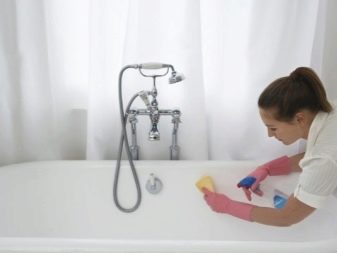
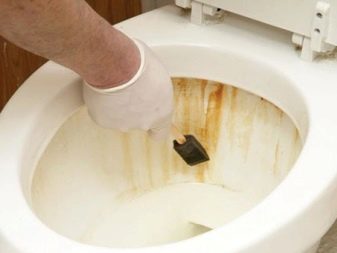
If you do not clean the bathroom from yellowness and limescale in a timely manner, this can lead to rust. A rusty coating may appear in the sink, bathtub, on the surface of the toilet, on metal taps and pipes. So that you don’t have to puzzle over how to clean the rust in the bathroom from one or another surface, you should follow a few simple rules:
- Do not leave metal objects in the bathtub or sink;
- it is necessary to timely eliminate leakage of the toilet bowl, faucets and pipes;
- Be sure to constantly maintain cleanliness in the bathroom;
- in case of rusty stains, it is recommended to immediately get rid of contamination.

Pollution on the surface of plumbing is formed not only from water. A common problem is the accumulation of urinary stone on the walls of the toilet. Urinary stone is formed due to irregular care and improper use of plumbing.
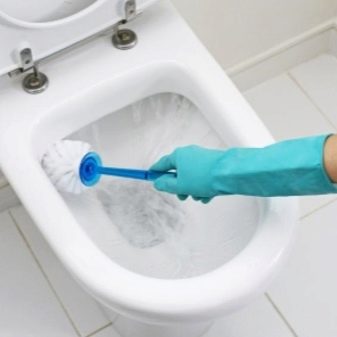
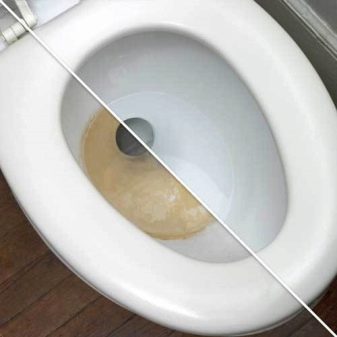
To prevent the formation of plaque will allow timely cleaning of the surface of the toilet, also do not forget to regularly press the drain button.
How to wash?
Before you start cleaning the bathroom, you need to decide what means you will remove this or that pollution. The choice will depend entirely on the type of contamination and the type of surface that needs to be cleaned.
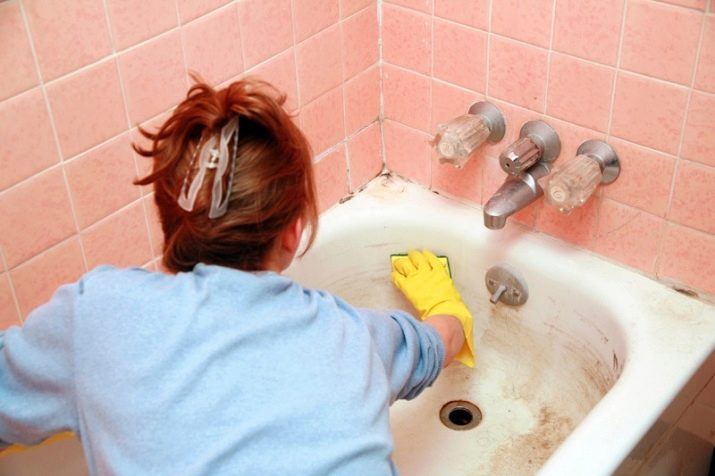
Special gels for chrome surfaces will help to clean the chrome tap. If necessary, the mixer can be treated with dishwashing liquid, lemon juice, salt, soda and vinegar.
Limescale deposits on chrome surfaces can be removed with vinegar. To do this, just wipe the faucet with a soft cloth dampened in essence. With old plaque, soda will help. To do this, rub the faucet with a toothbrush. To avoid the formation of plaque on the product, it is enough to wipe the chrome surface once a day with a dry cloth.
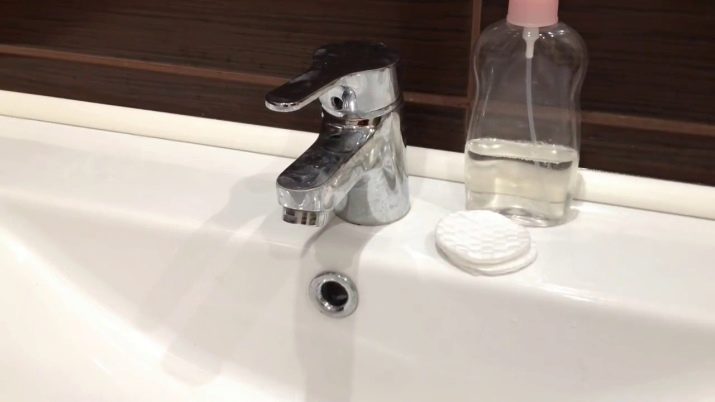
Limescale deposits on the mixer will help remove Coca-Cola. The cola contains acids that help to cope even with old calcareous formations. With a cola, you can clean not only the faucet, but also the bathtub, sink and toilet, just wipe the contaminated surface with a sponge dipped in this drink. The use of Coca-Cola as a cleaning agent has additional advantages:
- when applying liquid to a contaminated surface, it is not necessary to wear gloves;
- the cola does not have a sharp unpleasant odor that must be weathered from the room;
- such a tool will not harm the enamel, so it is suitable for cleaning new plumbing.

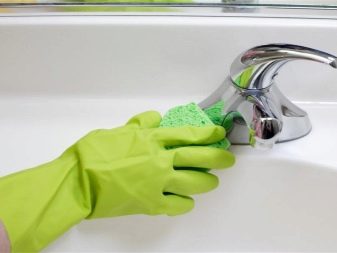
Citric acid can clean cast-iron baths. To do this, you need to draw hot water into the bath and pour 200 grams of citric acid into it. Leave the bath with the resulting solution overnight. Use citric acid to wash other surfaces with great care.
Rust in the bathroom and toilet can be removed with hydrogen peroxide. To do this, you need to prepare a solution of 150 ml of ammonia and 50 ml of peroxide, apply to a contaminated surface and let stand for twenty minutes. Peroxide also copes with mold. To remove the fungus, it is necessary to treat the affected areas with undiluted peroxide several times.
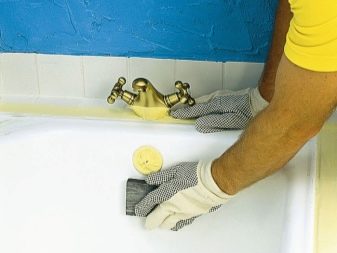

"White" It is an excellent disinfectant. “Whiteness” can process tile seams from mold. First, it is recommended to remove the mold mechanically by cleaning it from the seams. Then, using a brush, “White” is applied to the treated areas.
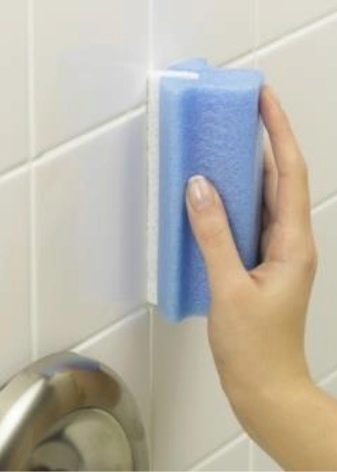
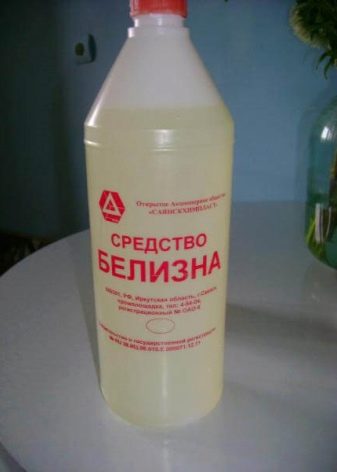
It is not necessary to wash off the product from the seams - “Whiteness” should be completely absorbed.
How to clean different types of surfaces in the bathroom?
Cleaning in the bathroom should be approached with all responsibility. An improperly selected cleaning agent can damage the bath enamel, the chrome plating of the mixer or various mirror surfaces. To wash a whitewashed bathroom is not difficult, you just have to consider the features of cleaning various types of surfaces.
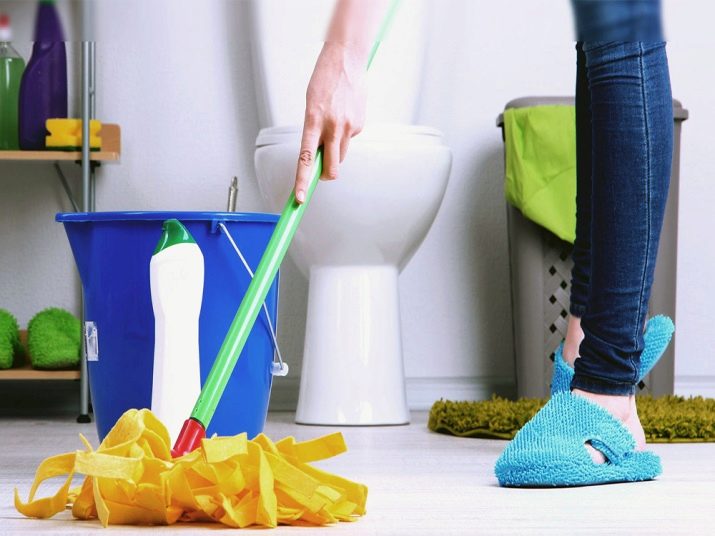
In addition to basic plumbing items, as well as the floor and ceiling, additional items that are in the bathroom need cleaning. In addition to observing the rules for cleaning different types of surfaces, It is important to consider in which order you need to clean the room:
- ceiling and lighting;
- walls;
- glass surfaces and mirrors;
- shelves, cabinets and other furniture;
- plumbing items;
- floor.
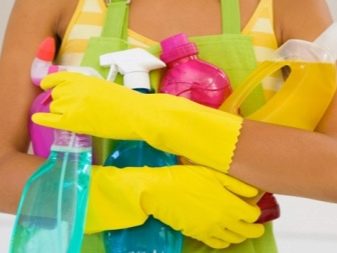
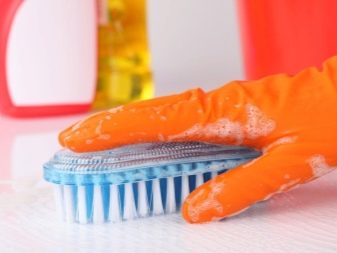
To remove dirt and accumulated dust from lighting devices, it is enough to wipe the surface of the products with a damp cloth. A very dirty inner and outer surface of the lampshades will not be enough just to wipe with a napkin. If possible, shades should be removed and rinsed in water with the addition of liquid soap or dishwashing detergent. Then the product should be washed under a stream of warm water, wiped with a dry clean cloth and left for some time on a clean, flat surface until it dries completely.
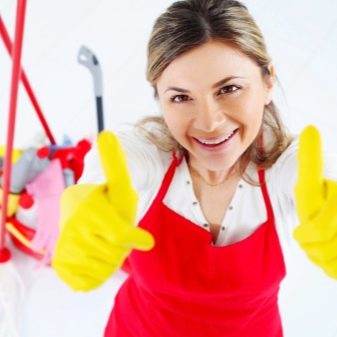
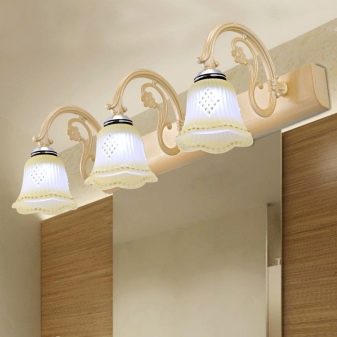
Mirrors and glass surfaces must be washed with extreme care. In addition to the fact that such a material is sensitive to mechanical damage, after cleaning it often remains stains. To wash the mirror without streaks, it is worth following the following algorithm:
- First of all, it is necessary to remove dirt, soap stains and limescale. To do this, you can use both special cleaning products and gel for washing dishes dissolved in water.Wash the surface with a soft cloth or soft sponge.
- Clean the remaining cleaning agent with a damp, clean sponge.
- We spray window cleaner onto the mirror surface. Rub the mirror with a microfiber cloth or newspaper to shine. If you did not have funds for windows or mirrors, you can make it at home with your own counterpart. To do this, one tablespoon of ammonia must be mixed with one glass of water. In the resulting solution, you can add a tablespoon of vodka or medical alcohol.
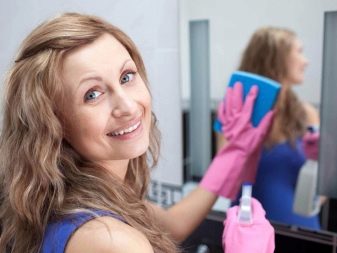

Glass shelves in the bathroom can be washed just like mirrors. To get rid of dirty stains on the cabinet, cabinets or other furniture, just wipe the surface with a damp cloth and dishwashing detergent.
A special type of surface includes tile joints and silicone sealant, which is often used when installing plumbing in the bathroom. Such places are most susceptible to mold. Any cleaner for the bathroom, diluted in warm water, will help get rid of mold on the sealant. A sponge moistened with a solution processes the affected areas. After surface treatment, residual mortar and mold must be washed off.
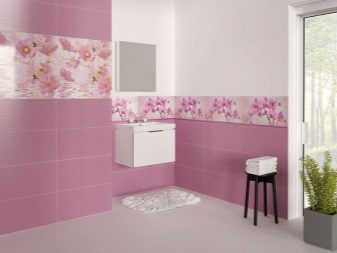
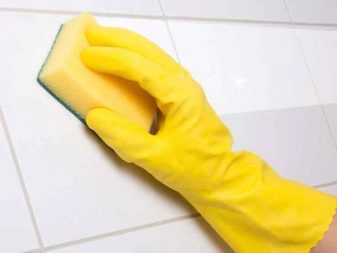
To prevent re-formation of the fungus, the treatment area must be disinfected. As a disinfectant, bleach can be used. The bleach must be applied to the sealant and left for 15 minutes, then carefully wipe with a brush. The remaining bleach must be washed off, and then wipe the silicone dry.
If, after thorough processing of the silicone sealant, the mold appears again, you will have to resort to radical measures to eliminate the fungus. The reason for the reappearance in this case lies in the mold spread area, which is under the sealant. In this case, remove the old layer of silicone sealant with a knife.
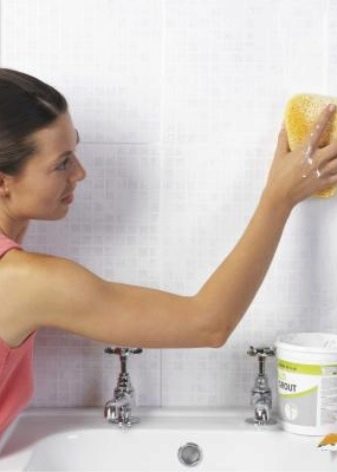
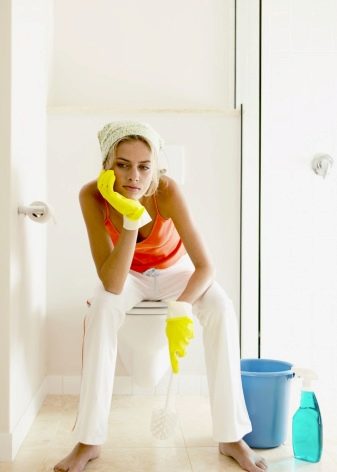
After removing the silicone, the seam must be thoroughly cleaned and treated with a disinfectant.
Isopropyl alcohol can be used for disinfection. Alcohol must be poured into the seam and left for half an hour. After that, the seam must be wiped with a dry cloth and left to dry completely for a day. A fresh layer of sealant is applied to the treated surface.
Various surfaces in the bathroom sometimes have to be cleaned not only from dirt, lime, rust and mold, but also from various coloring compounds. You can wipe the brilliant green from almost any surface with ordinary alcohol. Hydrogen peroxide will help to clean stains from potassium permanganate. Peroxide must be mixed with citric acid in a proportion of one to one. The solution is applied to contaminated areas for 5 minutes, and then washed off with water.
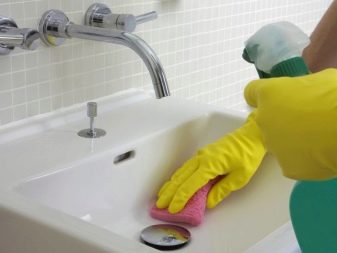

There is a more efficient and faster way to remove traces of potassium permanganate. Here you will also need hydrogen peroxide. The second cleaning component will be vinegar essence. To prepare a solution in this case is not required. First, the contaminated areas are wiped with peroxide, and then with vinegar until the spots disappear completely.
Wall and ceiling surfaces
Tile is one of the most popular materials used to decorate bathrooms. Without proper care, the tile is eventually covered with limescale, and mold appears in the seams. Therefore, the tile needs regular maintenance.
A suitable cleaning agent can be purchased at any household chemical store. For washing tiles it is highly recommended not to use powdersas there may be scratches on the surface of the tiles after them. It is allowed to use chlorine-based products. Chlorine helps to cope with lime stains and rust. A detergent for glasses and mirrors, which includes ammonia, is also suitable.

It is not necessary to buy special detergents to clean the ceramic tiles.A regular soap solution is suitable for regular care, provided that there is no lime or rust on the tile.


To eliminate heavy pollution, you can use 6% vinegar. Vinegar must be sprayed onto the tile and left for a while. Then contaminated areas need to be rubbed with a brush. After surface treatment, vinegar residues are removed from the wall with a damp cloth. Clean the tiles with a microfiber cloth.
Ammonia will help restore glitter to the tile. In two liters of water, you need to dilute a tablespoon of ammonia. The solution is sprayed onto the walls and left for 5 minutes. Then the tile must be wiped with a damp cloth. After the remnants of the ammonia solution are removed, the wall must be wiped dry.
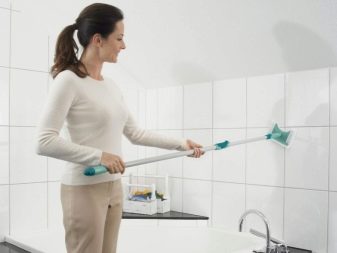
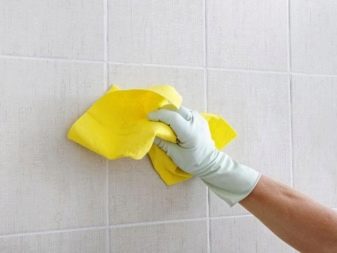
The tiled floor, in addition to regular cleaning, requires constant disinfection, as it is more susceptible to contamination and the rapid spread of bacteria than the walls and ceiling. The necessary means for washing and disinfecting can be prepared with your own hands. This will require:
- four tablespoons of salt;
- four tablespoons of soda;
- 100 ml of alcohol;
- 4 liters of water.
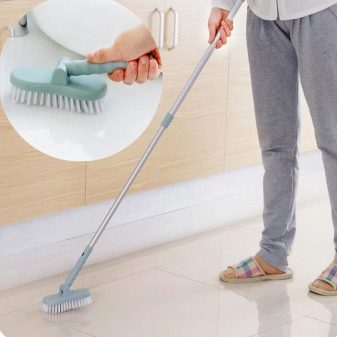
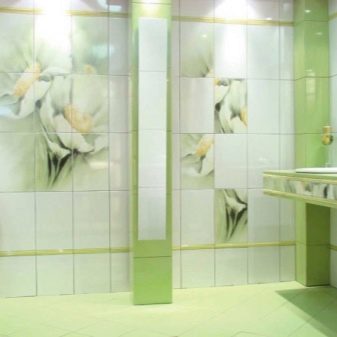
To decorate the walls and ceiling in the bathroom, PVC panels are often used. Plastic panels are much cheaper than other finishing materials. In addition, plastic is resistant to moisture and is not afraid of water.
Do not use metal sponges or hard brushes (they can scratch the surface) to clean plastic panels. The temperature of the water used during cleaning should not exceed 40 degrees. Cleaning products must have a liquid or gel structure (powders must be discarded).
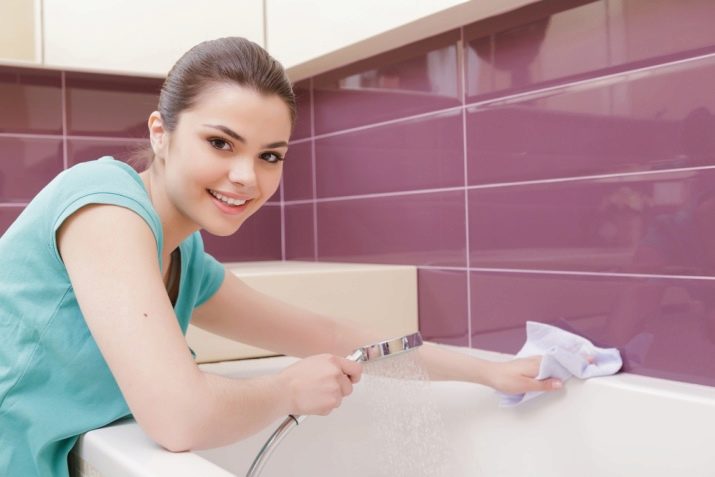
In addition to special store cleaning products, you can use solutions prepared by yourself. The simplest option is based on laundry soap or dishwashing gel. You can also wipe the plastic panels with vinegar or vodka.
If yellowness appears on PVC panels, chlorine bleach will help to cope with it. Three tablespoons of bleach must be diluted in 10 liters of water. With a soft brush dipped in the solution, remove the yellowness.
To clean plastic panels on the ceiling, use a special mop. The surface can be treated with soapy water or alcohol-containing agents (so there will be no stains on the ceiling).

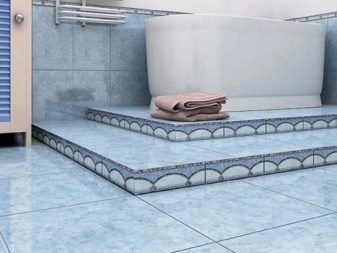
Bath
For bathing newborns, you need a separate bath, which can not be used for any other purpose. The baby's skin is very delicate and sensitive to various irritants. The baby bath must be regularly cleaned of various kinds of contaminants and disinfected.
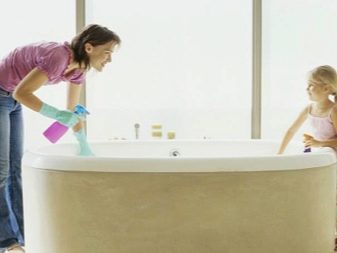

Conventional chemical detergents and powders are not recommended, as they can cause an allergic reaction in a child. Modern manufacturers are ready to offer special products designed specifically for children. Such cleaners do not contain dyes, have antibacterial properties and do not cause allergies.
A new bathroom must be sanitized before the first bath. To do this, you must first wash the bath with baby soap, and then pour over boiling water. For subsequent disinfection, soda is most often used. Baking soda is applied to a damp sponge and the bath is treated.
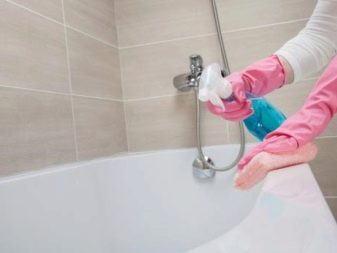

After each such treatment, it is important to carefully remove the remaining soda from the surface of the product.
The bathtub with hydromassage, in addition to regular cleaning, needs periodic disinfection. The peculiarity of cleaning the jacuzzi is that, in addition to the tank, it is also necessary to clean the internal parts of the hydromassage system. A bowl of such a product can be made of the following materials:
- castable marble;
- ferrous metals (steel and cast iron);
- acrylic.

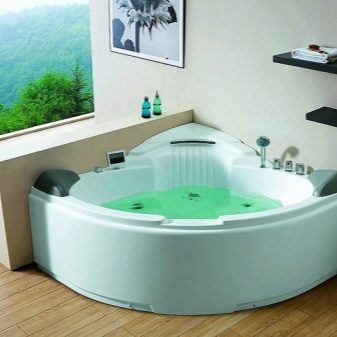
Products made of cast marble and ferrous metals are easy to maintain. Buying special detergents for surface treatment is not necessary. The tank is cleaned with ordinary soapy water.Detergents for acrylic bathtubs can be used to remove heavy impurities.
The acrylic whirlpool bath must be cleaned with extreme care. Such material is sensitive to mechanical stress. Metal brushes and other rough materials can ruin the enamel. Do not use different types of solvents for cleaning.
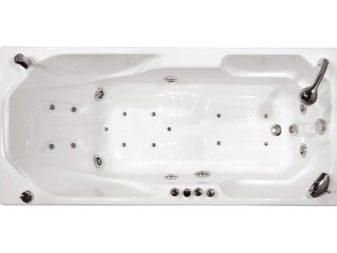
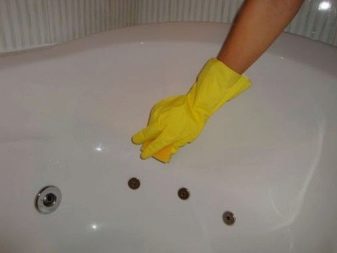
Suitable detergents must have a gel or foam structure. Powdered detergents can damage acrylic. To care for the acrylic surface, special cleaning products are released, so there is no need to clean such a bath with folk methods. To keep the bath clean You can periodically wash the surface with liquid soap.
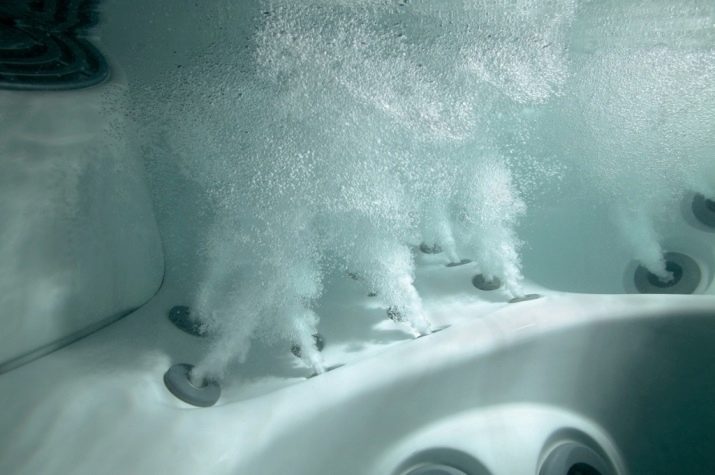
The process of cleaning and disinfecting a spa bath from any material is as follows:
- The tank is filled with hot water ten centimeters above the nozzles.
- A special detergent or dishwashing gel is added to the water.
- The maximum pressure level is set and the hydromassage system is turned on for fifteen minutes.
- Water needs to be drained and the bath rinsed.
- The cleaning procedure must be repeated, but now with cold water and without the addition of cleaning products.
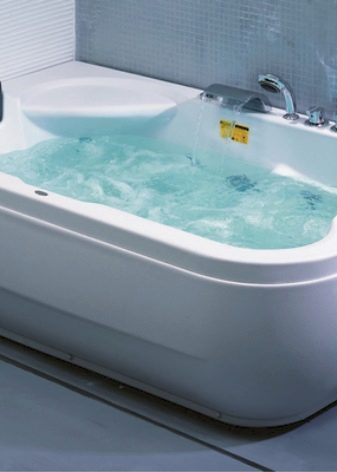
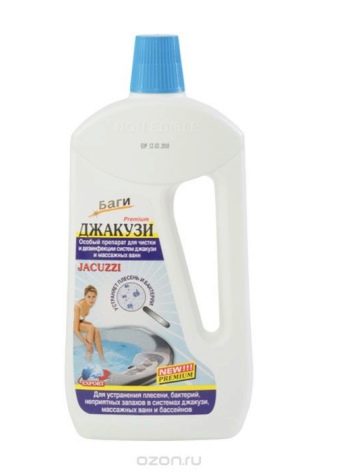
Cast iron and steel bathtubs are strong and durable, but the enamel coating of such products requires constant care. In order not to damage the enameled surface, it is worth abandoning aggressive cleaning products. Suitable cleaning products can be purchased at any household chemical store.
No worse than store-bought products, the task of removing dirt from an enameled surface is to help lemon juice. The cast-iron bath is treated with lemon juice, kept for ten minutes and rinsed with water. In the fight against heavy pollution (rust or old limescale), expensive store-bought products or a solution of ammonia and peroxide will help.
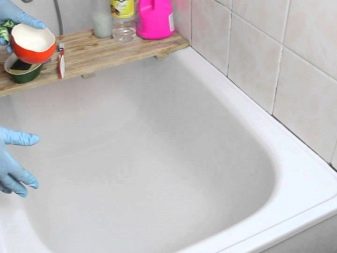
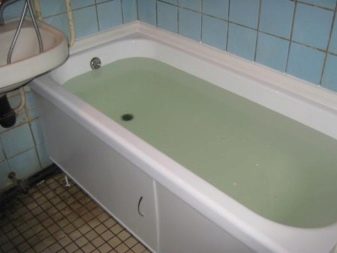
To clean and bleach old cast-iron baths, it is necessary to resort to more radical methods and aggressive means. After many years of service, the plumbing wears out:
- mechanical damage appears;
- the bath loses its pristine shine;
- the surface is covered with limescale and rust.
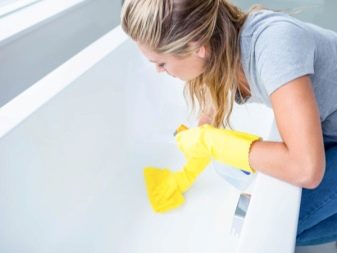

When treating an old bathtub with cleaning products, you no longer have to fear very much that the product will deteriorate. An iron brush and oxalic acid can be used to remove rust. The main layer of rust must be brushed off. Then, a mixture (in the form of a paste) of oxalic acid and water is applied to contaminated sites for half an hour. After processing, the oxalic acid paste must be washed off.
The easiest way to clean an old bath is to clean it with any abrasive cleaner. Places of accumulation of strong plaque and rust should be rubbed with an iron brush. Instead of household chemicals, you can use soda.
Plumbing and pipes
Chrome-plated taps are easiest to clean with special products for this type of coating. Instructions for the proper use of cleaning products can always be found on the product label. Before buying a cleaning product, it is worth considering some nuances:
- Means intended for washing sinks, bathtubs, toilets, as well as rust removers and various bleaches cannot be used. After treatment with such agents, dark spots may form on the chrome coating.
- Powdered detergents can damage the chrome surface, causing small scratches on it. The choice should be made in favor of gels, as well as liquid and foamy agents. If the dirt on the chrome surface is slight, then they can be wiped off with a dishwashing gel.
- Do not mix different chemical cleaners.


Baking soda or citric acid can give the original shine to the mixer and tap.To do this, thoroughly treat the surface with a sponge dipped in a solution of citric acid or sprinkled with soda.
A sink made of any material in the bathroom can be cleaned with universal cleaning products for plumbing. Water stains can be wiped off with alcohol or vinegar. Contamination on the surface of the sink made of artificial stone can be removed with toothpaste or gruel from soda with water.
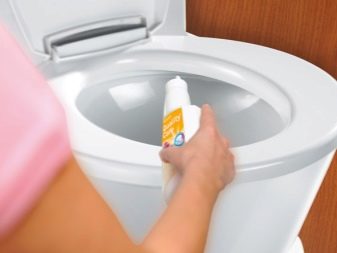
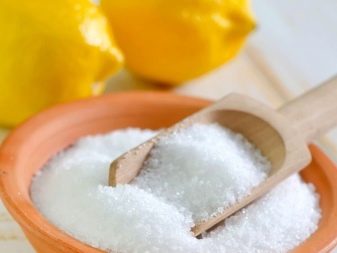
In order to clean the toilet from urinary stone and limescale, you can purchase ready-made products designed for these purposes. Cleaning products for washing the toilet differ in composition:
- acidic;
- alkaline;
- based on chlorine.
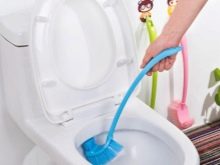
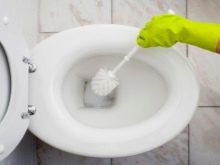
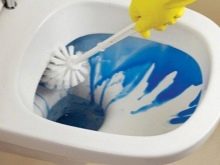
Acids of high concentration will help to cope with long-standing severe pollution:
- The electrolyte used for batteries. Do not use if sewer pipes are made of plastic.
- Oxalic acid powder.
- Iodine Chloride Removes all types of stone and rust. Do not use if sewer pipes are made of cast iron.
- Hydrochloric acid. Removes all types of stone.
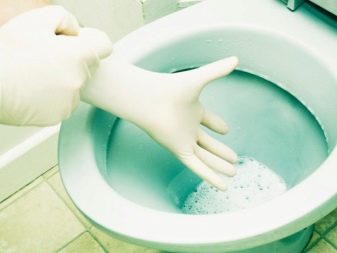
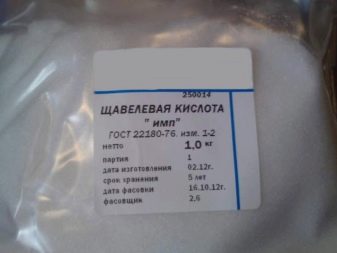
Over time, rust and calcareous deposits appear on the surface of metal pipes. Before the complete removal of rust formations, the pipe must be machined. Rust is cleaned with sandpaper or a metal brush. Then the outer surface of the pipe must be processed in one of the following ways:
- A solution of vinegar and citric acid in a ratio of 1 to 1 should be applied to areas previously treated with sandpaper, and left for a couple of hours. Wash the solution with soapy water.
- Two tablespoons of baking soda should be mixed with 1/3 cup of water. Apply the mixture for 15 minutes. Rinse with water with a few drops of vinegar.
- Special means.
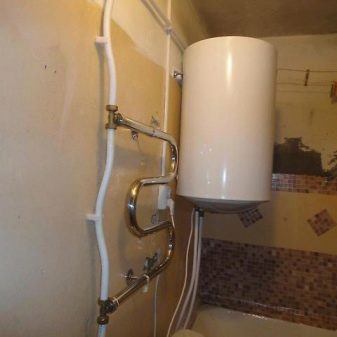
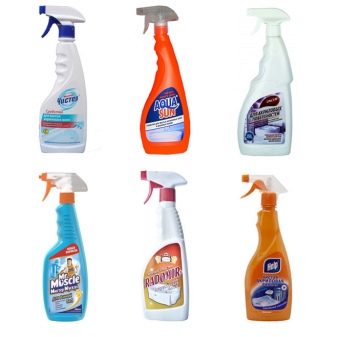
People's councils
Not only expensive cleaning products can help fight mold that has formed on silicone sealants or other surfaces. Time-tested folk recipes no less effectively cope with this type of pollution. It will not be difficult to clean the silicone from fresh mold - just wash off the fungus and treat the surface with an antiseptic. Dealing with old mold will be much more difficult. Consider some effective methods to combat fungus in the bathroom:
- Tea tree oil (one teaspoon) should be diluted in a glass of water at room temperature. Using a solution of essential oil, treat the problem area. After surface treatment, it is not necessary to wash off the applied solution. Tea tree oil has antiseptic properties, which will help prevent the re-formation of mold.
- In two and a half liters of water it is necessary to breed one glass of borax. Using a toothbrush moistened in a solution, mold-affected areas are rubbed. After processing, there is no need to wash the solution from the surface. Such impregnation forms a protective layer against fungus.
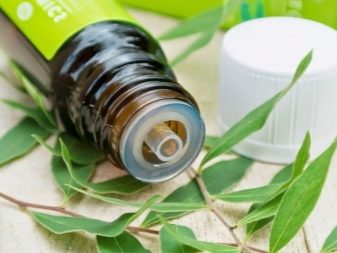

- Half a teaspoon of baking soda needs to be diluted in 500 ml of warm water. The solution is rubbed into the moldy area using a brush. If necessary, processing should be carried out several times. After removing the fungus, the solution must be washed off.
- The moldy surface can be treated with ordinary undiluted vinegar. After one hour, vinegar must be removed with a damp sponge.
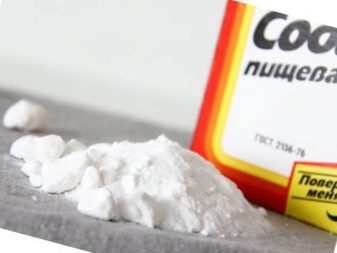
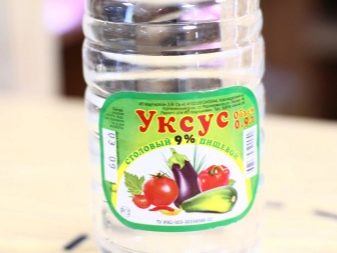
There is a universal tool for cleaning almost all types of surfaces in the bathroom. This means you can process faucets, ceramic tiles and plumbing. To prepare such a solution and clean it with a contaminated surface as follows:
- Vinegar (one glass) must be heated on the stove. Boil vinegar is not necessary. The temperature of the liquid should be such that a finger can be lowered into it and not burned.
- Using a funnel, pour warmed vinegar and a glass of dishwashing liquid into the spray gun. Dishwashing liquid can be replaced with liquid soap.
- The resulting mixture must be shaken well.
- The solution must be sprayed onto the surface to be cleaned. Further, it is necessary to evenly distribute the cleaning agent on the surface with a sponge and leave for half an hour.
- The solution must be completely washed off.
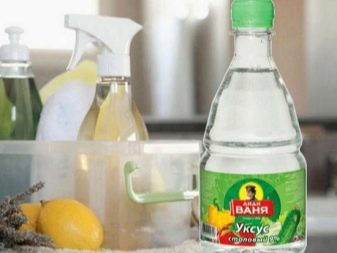
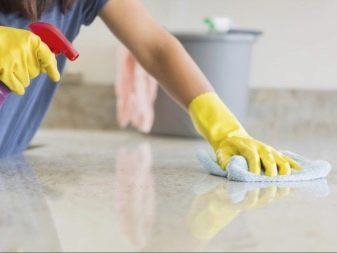
The anti-slip coating of the bath requires special care and care in cleaning. The wrong choice of acrylic bath detergent can ruin the enameled surface.
Limescale can be removed using improvised products such as vinegar or lemon juice. The lime-covered area should be treated with the selected product and wait twenty minutes. Then vinegar or lemon juice must be washed off with warm water.
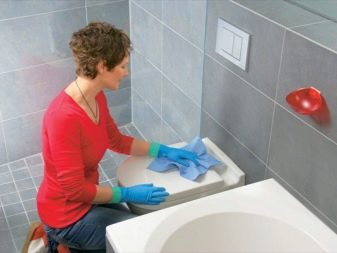
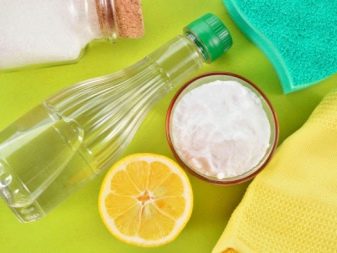
An old cast-iron bath with plaque and rust can be cleaned with ammonia. First, the surface of the bath must be treated with hot water. To do this, just pour boiling water into it and leave it for 15 minutes, after which the water needs to be drained. Then the bath is treated with ammonia. The ammonia must be given some time to soak.
After half an hour, soda is applied to the surface (can be replaced with washing powder). Use a hard sponge or iron brush to rub the contaminated areas intensively. After cleaning, soda and dirt must be washed off with water.

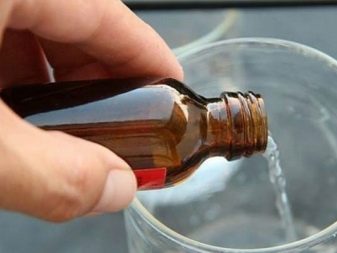
See how to wash your bathroom quickly and shine in the video below.
